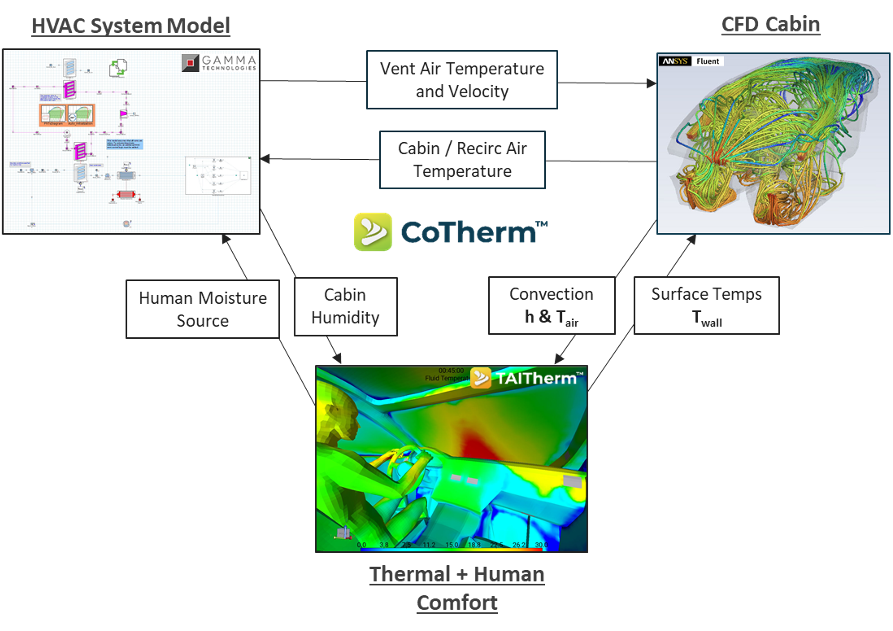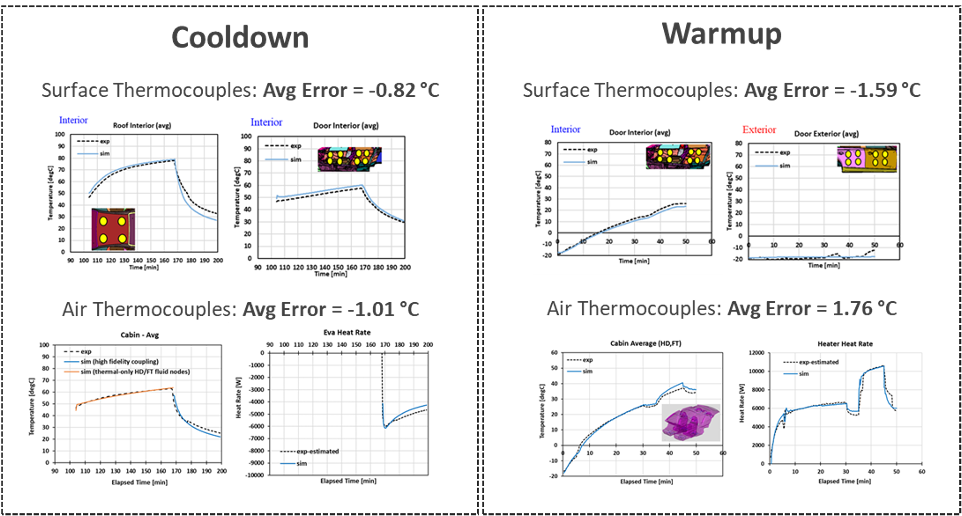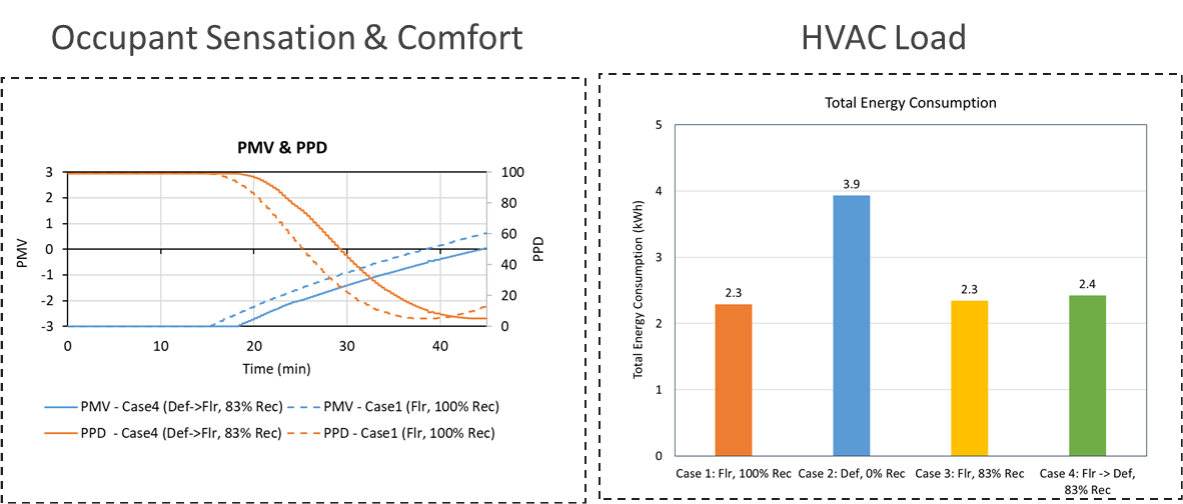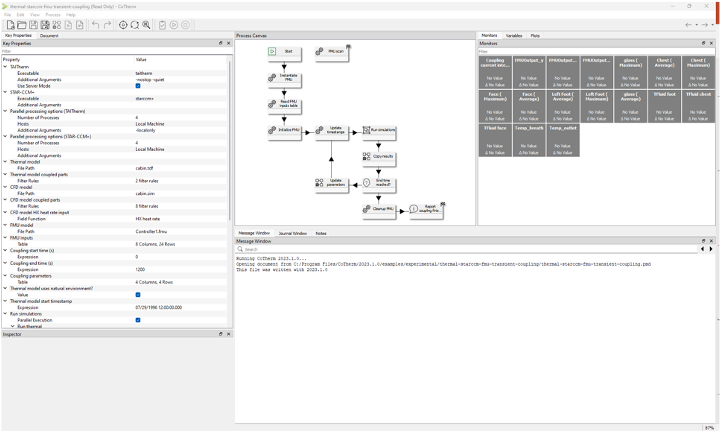This blog will explore the application of a high-fidelity 3-tool coupling simulation workflow to the automotive cabin for energy and human thermal comfort analysis. The automotive cabin is a dynamic system that requires a comprehensive analysis of the vehicle thermal state, the vehicle control system response, and the occupant thermal state in order to meet industry requirements for cabin and HVAC system analysis.
Typical requirements are as follows:
- High-accuracy local temperature predictions in the cabin (within ~2-3 degrees)
- The ability to model system performance as a function of the dynamic vehicle state during a drive cycle
- The ability to extract energy consumption data (HVAC load, cabin heat distribution)
- The ability to predict occupant comfort
Meeting these requirements requires a coupled, multi-physics simulation methodology. For this reason, the high-fidelity 3-tool coupling workflow is becoming the standard for high-accuracy, transient cabin simulations.
3-Tool Coupling for Cabin Systems
The 3-tool coupling simulation workflow for predictive cabin simulation is coupling between TAITherm, a CFD solver, and a 1D system modeling tool or FMU. TAITherm provides comprehensive heat transfer modeling including human thermal comfort predictions. A preferred CFD solver is integrated to provide accurate convection modeling for the cabin interior. Finally, the 1D system modeling tool solves the dynamic vehicle state and control system response during the drive cycle. CoTherm automates the coupling process and facilitates the passing of information between the tools. The flow of data is generally as follows:
- The 1D system tool passes vent boundary conditions to the CFD tool. The CFD tool passes recirculation air data back to the 1D system tool.
- Thermal-CFD coupling between TAITherm and the CFD tool enables the conjugate heat transfer solution. TAITherm passes surface temperatures to the CFD tool. The CFD tool passes convection data to TAITherm.

Note, the flexibility of CoTherm as a workflow automation tool enables countless data exchange quantities between the tools depending on the application. For this reason, customers frequently choose to customize the workflow as desired. For instance, moisture data can optionally be exchanged between the tools (as shown in the graphic). In addition, the CFD tool can be used to solve for the HVAC internal flow field, such that local vent flow rates and temperatures are predicted by the CFD tool. In this scenario, the 1D system tool would pass heat exchanger heat rates to the CFD tool.
Transient Coupling
For maximum accuracy, a fully transient coupling scheme is recommended for the 3-tool coupling simulation workflow. In this coupling scheme, each of the three solvers are run in transient. As the solution marches forward in time, CoTherm facilitates the data exchange between the three tools at predefined intervals.

The flexibility of CoTherm again enables many opportunities for customization of the coupling scheme. In certain applications, innovative coupling workflows can be applied to optimize the classic tradeoff between computational time and accuracy.
Validation
Accurate thermal predictions are of critical importance in order to produce reliable human thermal comfort and energy management calculations. For this reason, the 3-tool coupling methodology has been extensively validated, demonstrating consistent accuracy for temperature predictions over a wide range of test conditions.

Application: Defog
In a cold start cabin scenario, air recirculation is desirable to maximize the heating rate of the cabin and occupant comfort. However, moisture from vehicle occupants can also be problematic for window fogging. When designing the vehicle's HVAC system, it’s necessary to explore the tradeoff between the degree of fogging and occupant comfort/heating efficiency.
The 3-tool coupling simulation workflow provides the ability to obtain high-accuracy, local temperature predictions on the glass surfaces and on the occupants. The animation below shows the prediction of local defog on the interior glass surfaces for a given HVAC response (white represents condensation/fogging).
When identifying the optimal HVAC controller response to mitigate fogging, one must also maximize the occupant's comfort and energy consumption. In the analysis below case 1 (100% recirculation, floor mode) represents the ‘max comfort’ case, which expectedly resulted in significant fogging. Case 2 represents the ‘max defog’ case, which also resulted in minimal comfort and minimal cabin heating efficiency. Case 4 represents the optimal HVAC response, for which fogging is mitigated and occupant comfort/heating efficiency is maximized.

Application: Energy Analysis
The high-fidelity cabin simulation workflow with TAITherm provides the ability to seamlessly extract energy analysis data from the cabin and full vehicle. One can perform an energy balance over the cabin surfaces to quantify the distribution of heat transfer modes to the cabin (e.g. solar, convection). One can also perform the energy balance overall vehicle solid components to quantify the total change in vehicle thermal energy.


Downloadable CoTherm Demos
Try 3-tool coupling for yourself with the downloadable examples released with CoTherm v2023.1.0.
Explore fully transient 3-tool coupling in a simple cabin.
Explore the effect of radiant panel heating on human thermal comfort and energy consumption.
The demos were designed to run quickly on any workstation. They are available for download in the following configurations:
- TAITherm <--> STAR-CCM+ <--> GTSUITE
- TAITherm <--> Fluent <--> GTSUITE
The CoTherm templates are available in the CoTherm installation directory. The path might look something like this:
“C:\Program Files\CoTherm\2023.1.0\examples\experimental”

Demo models are available for download via the support site link below:
https://support.thermoanalytics.com/hc/en-us/articles/15737379965075-CoTherm-v2023-1-0-Installations
If you want to learn more about 3-Tool Coupling using the Human Thermal Extension and Cotherm, please feel free to request a live demo of our software.
Visit our website at suppport.thermoanalytics.com for
- FAQs
- Webinars
- Tutorials
Get help from our technical support team:

